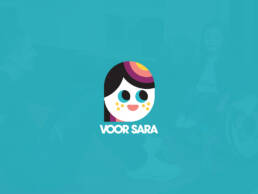As the proud ambassador of The Dutch Stichting Voor Sara I keep fighting for Sara and all other kids suffering from rare muscle diseases.
The Dutch Stichting Voor Sara was established at the end of 2016 by Sara Verbrugges parents. Sara is a lively 2 year old girl from Dordrecht in The Netherlands who was born with the incurable muscle disease MDC1A.
MDC1A is a hereditary muscle disorder often noticed at birth or within the first few months of life. It is a type congenital muscular dystrophy (CMD) and has an incidence of 1 in 30,000 to 1 in 100,000. MDC1A is caused by a defect in the LAMA2 gene which is responsible for the production of laminin α2 protein (previously called merosin). MDC1A is sometimes referred to as LAMA2-related muscular dystrophy.
The aim of the foundation is to have more research done into this disease. But also to inform the general public about the many unknown and rarely occurring muscle diseases and the impact these have on sufferers and their families.
Muscle weakness
MDC1A is a congenital muscle dystrophy which manifests itself as muscular weakness . Babies with MDC1A often appear floppy and may not move as much as other babies. Children with MDC1A reach motor milestones later than other children and only a very small proportion of children with MDC1A are able to walk independently. Muscle weakness does not tend to rapidly progress and motor function remains relatively stable throughout childhood. When children reach puberty however, and grow taller and heavier, children might experience additional difficulties. Children may develop, or be born with, ‘contractures’. A very common problem in children with MDC1A is weakness of the respiratory muscles, which results in frequent chest infections and poor breathing at night. Respiratory issues usually stabilize or improve in the first few years. In adolescence however, respiratory function may begin to decline. Most children with MDC1A also develop a curvature of the spine (scoliosis). Another frequent problem is feeding difficulties and the accompanied weight loss. In the worst cases patients die in childhood.
There is no cure for MDC1A and no therapy that combats the underlying cause. Physiotherapy can help prevent the ‘contractures’, children may develop or are borne with, and a programme of exercises should be worked out with a physiotherapist very soon after diagnosis, but surgery is often eventually required to release contractures. It is important to monitor respiratory function during the night and children may need to use a ventilator at night with a special facial or nasal mask. For some patients this is insufficient and a tracheostomy is needed. Respiratory issues usually stabilise or improve in the first few years, but, in adolescence however, respiratory function may begin to decline requiring more ventilator support. It is important to make sure that children with MDC1A are well nourished. Often the swallowing muscles are weak and feeding supplements are needed.
Research
Stichting Voor Sara believes that by investing in research it must be possible to halt these rare muscle diseases. Because Sara is not alone. There are thousands of children with some form of rare muscle disease.
A research team of the Expertisecentrum Nemo and the university of Maastricht have started with a research plan that could help countless children. For this research, however, half a million euro is needed. With your support we can raise this sum. A breakthrough would not only help Sara but many more children.
Give them all a chance for a healthier future, visit the website and make a donation.


